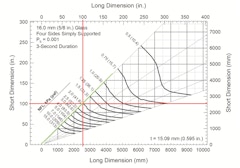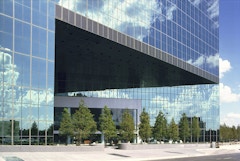46 results
-
The stability of monolithic glass fins is reasonably well defined; as an elastic material it behaves in a similar manner to other elastic materials…
-
Glass Balustrade Design
- Paper by Richard Green, PE, SE, P.Eng, CPEng IntPE(Aust), APEC Engineer · Andrew Crosby, PEng · Terrence McDonnell S.E., P.E., P.Eng., SECB
Glass handrail design in the United States lags behind best practice in other parts of the world. There can be as much as a factor of four (4)
-
The Great Spandrel Glass Debate
- Paper by Richard Green SE PE P.Eng CPEng IntPE APEC Engineer M.ASCE M.IEAust, Principal / Owner
As we change the rules of thermal performance for facades, we are changing the conditions the glass is subject to in shadow boxes and glazed spandrel… -
Comparison of Historical Weathered Annealed Glass Failure Data to ASTM E1300
- Paper by Nabhajit Goswami; Student · Stephen M Morse; Assistant Professor, Civil and Environmental Engineering Assistant Professor, Mechanical Engineering-Engineering Mechanics Michigan Tech University
Historical published weathered annealed failure data consisting of 13 samples were collected and glass failure prediction model surface flaw
-
Design of Facade and Overhead All-Glass Structures in Building Renovations
- Paper by Alfonso E. Lopez, P.E. · David Dunham, P.E. · Andrew Duncan
The contemporary renovation of historic buildings often includes all-glass structures that allow architects to preserve the original building design
-
A Structural Glass Design Manual
- Paper by Richard Green PE SE P.Eng CPEng IntPE(Aust) APEC Engineer · Terrence McDonnell S.E., P.E., P.Eng., SECB · Andrew Crosby BASc, P.Eng., LEED® AP BD+C
Other than limited special cases, there is a lack of standards providing guidance on the design of structural glass. This has resulted in an ad-hoc
-

The Glass Failure Prediction Model
- Paper by James G. Soules, P.E., S.E., P.Eng., SECB, F. SEI, F. ASCE, Graduate Student, Department of Civil, Environmental, and Construction Engineering Stephen M. Morse, P.E., Ph.D., A.M, ASTM, Assistant Professor of Civil and Environmental Engineering H. Scott Norville, P.E., Ph.D., F. FTI, F. ASCE, F. ASTM, Professor, Department of Civil, Environmental, and Construction Engineering
ASTM E 1300 Standard Practice for Determining Load Resistance (LR) of Glass in Buildings defines the load resistance of a glass construction as being… -

Advances in Effective Thickness
- Paper by Adam J Nizich, P.E., Senior Consulting Engineer Andrea M. La Greca, P.E., Consulting Engineer Laura Galuppi, PhD, Assistant Professor of Solid and Structural Mechanics
Effective thickness is a simplified method for the structural evaluation of laminated glass section properties. The method consists of defining the… -

Glass Strength Under Point Loading
- Paper by Joshua Schultz, Ph.D, P.E., LEED AP, ENV SP, John Knowles, PE SE, Kedar Malusare,
Structural glass is used in a range of building applications, and while the ASTM E1300 has recently been updated to provide a design method to… -

Glazing Design By ASTM E 1300
- Paper by H. Scott Norville, P.E., Ph.D., F. FTI, F. ASCE, F. ASTM, Professor Stephen M. Morse, P.E., Ph.D., A.M, ASTM, Assistant Professor of Civil and Environmental Engineering James G. Soules, P.E., S.E., P.Eng., SECB, F. SEI, F. ASCE, Graduate Student, Department of Civil, Environmental, and Construction Engineering
ASTM E 1300 “Standard Practice for Determining Load Resistance of Glass in Buildings” defines the load resistance of a glass construction as being… -

Control Tower Glass Design
- Paper by Daniel McCormick, P.E., PMP, M.ASCE · Stephen M. Morse, Ph.D., P.E., M.ASCE · Scott H. Norville, Ph.D., P.E., F.FTI, F.ASTM, F.ASCE
ASTM published the first version of ASTM E2461-05: Standard Practice for Determining the Thickness of Glass in Airport Traffic Control Tower Cabs in
-

Case Study: Renovation of Fountain Place
- Paper by Alfonso Lopez P.E. · David Dunham P.E · Diarmuid Kelleher P.E., S.E.
Fountain Place is a project that exemplifies the latest technology and applications in building skin design and jumbo structural glass applications,
-

Fixed Edge Supports
- Paper by James G. Soules, Ph.D., P.E., S.E., P.Eng., SECB, F.SEI, F.ASCE · Stephen M. Morse, Ph.D., P.E., M.ASCE · Scott H. Norville, P.E., Ph.D.
Model building codes and standards in the United States use a probabilistic model to define glass load resistance (LR). In general, these model
-

Glass and Electromagnetic Eavesdropping Protection
- Paper by Eric Stein
Glass is a key component in building design. Benefits of utilizing Insulating Glass Units (IGUs) within a building facade are well understood,
-
Insulating Glass Unit Gas Loss
- Paper by Mark K. Schmidt, M.Eng., S.E., Principal and Unit Manager Stephen M. Morse, PhD, P.E., Assistant Professor
Concerns over time-dependent argon permeation through the perimeter edge seals of insulating glass units (IGUs) led the authors to utilize two… -
Consistency In Glass Design
- Paper by Joshua Schultz, PhD, PE, LEED AP · Grace Dojan
Glass structural elements have become increasingly common to the point of ubiquity; however, there currently is no universally recognized and
-

Simplicity is Deceiving
- Paper by Giovanni De Mari, BSc(Hons) MScEng Ing CEng MICE · Kerry Hegedus, architect (WA, AZ)
The case study presented is a 195 meters tall office tower with a raised podium made of 16 meters full height glass panels (and smaller). The panels
-
Determination of Surface Flaw Parameters for Annealed and Fully Tempered Glass Exposed to NaCl
- Paper by Nabhajit Goswami, PhD · Joshua Schultz, PhD, PE, LEED AP · Patrick Ferro, PhD, PE, MBA · Stephen M Morse, PhD, PE
The use of glass in the exterior facades provides greater light transmission into the building and improved views for occupants. Coastal areas in
-

Designing Structural Laminated Glass
- Paper by Vaughn Schauss,
Laminated glass with standard PVB has long been used for safety and security due to its ability to adhere the broken glass fragments together. As the… -

Museum of Fine Arts, Houston
- Paper by Roman Schieber, Thorsten Helbig,
Steven Holl Architects designed two new buildings in the Museum District in Houston, Texas. Knippers Helbig is the facade consultant of both…